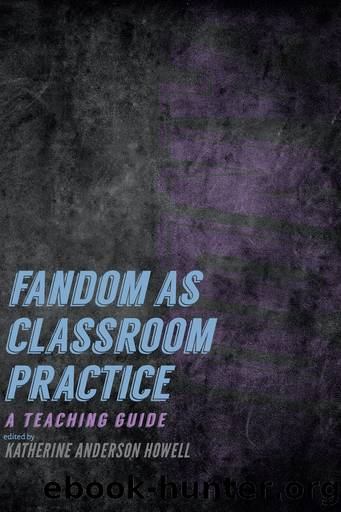Fandom as Classroom Practice by Katherine Anderson Howell

Author:Katherine Anderson Howell [Howell, Katherine Anderson]
Language: eng
Format: epub
ISBN: 9781609385682
Barnesnoble:
Publisher: University of Iowa Press
Published: 2018-05-15T00:00:00+00:00
7
TEACHING DECONSTRUCTION USING FAN VIDS
Shannon K. Farley
As a fan scholar who is writing her dissertation on the history of rewriting, I have been building an argument for some time for the power of fan work as textual criticism. Iâve been watching vids and following vidders for even longer. Fans of vids have long recognized that some videos succeed in showing their audiences a side of the source text that they had never seen before. Barry (2002), whose text I used with my junior year writing class for comparative literature majors, states that a deconstructive reading aims to produce disunityâto show that what had appeared to be a coherent text is in fact unstable and contradictory. This is the major characteristic of a deconstructive reading. Vids often enact these very kinds of deconstructive readings.
For undergraduate literature majors, the theory of deconstruction is often quite challenging even as other styles of literary criticism come easily. For this reason, I felt the need to develop a lesson that made the abstract nature of deconstruction as concrete as possible. The visual quality of deconstructive videos made the act of deconstructive reading as concrete as I could make it in the classroom.
Vidding as an aspect of fan culture dates back to 1975, when college student and Star Trek club member Kandy Fong first set a slideshow of static images from Star Trek to music during a fan convention. Since that time, both the technology used to make vids and the messages vidders wish to send with their work have evolved. Some vids celebrate certain characters or story lines, some serve as recruitment tools to convince other fans to join a fandom, and some take a more critical stance in relation to their source texts. Coppa (2008, 1) notes that âfannish vidders use music in order to comment on or analyze a set of preexisting visuals. . . . In vidding, the fans are fans of the visual source, and music is used as an interpretive lens to help the viewer to see the source text differently. A vid is a visual essay that stages an argument, and thus it is more akin to arts criticism than to traditional music video.â That urge to critique, the visual nature of fan vids, and the pop culture source texts make fan vids excellent examples of textual criticism in an undergraduate classroom.
As part of a university-wide writing program, junior year writing exists to build on a basic undergraduate writing class and instruct upperclass students on writing in their chosen fields of study. When I teach junior year writing for the comparative literature majors at the University of Massachusetts at Amherst, I begin with six weeks of instruction and practice in the schools of literary criticism. Utilizing the tools of literary criticism is the main mode of writing in comparative literature, but many of my students are still unfamiliar with them by the time they reach their junior year. Thus I need to approach them in an introductory fashion. To
Download
This site does not store any files on its server. We only index and link to content provided by other sites. Please contact the content providers to delete copyright contents if any and email us, we'll remove relevant links or contents immediately.
| Arts & Humanities | Health |
| Language Arts | Library Skills |
| Mathematics | Reading & Phonics |
| Science & Technology | Social Studies |
The Art of Coaching Workbook by Elena Aguilar(50108)
Trainspotting by Irvine Welsh(21023)
Twilight of the Idols With the Antichrist and Ecce Homo by Friedrich Nietzsche(18299)
Fangirl by Rainbow Rowell(8786)
Periodization Training for Sports by Tudor Bompa(7918)
Change Your Questions, Change Your Life by Marilee Adams(7374)
This Is How You Lose Her by Junot Diaz(6438)
Asking the Right Questions: A Guide to Critical Thinking by M. Neil Browne & Stuart M. Keeley(5356)
Grit by Angela Duckworth(5297)
Red Sparrow by Jason Matthews(5195)
Paper Towns by Green John(4797)
Room 212 by Kate Stewart(4736)
Ken Follett - World without end by Ken Follett(4443)
The Sports Rules Book by Human Kinetics(4078)
Housekeeping by Marilynne Robinson(4062)
Double Down (Diary of a Wimpy Kid Book 11) by Jeff Kinney(3925)
Papillon (English) by Henri Charrière(3904)
Exercise Technique Manual for Resistance Training by National Strength & Conditioning Association(3786)
The Motorcycle Diaries by Ernesto Che Guevara(3785)
